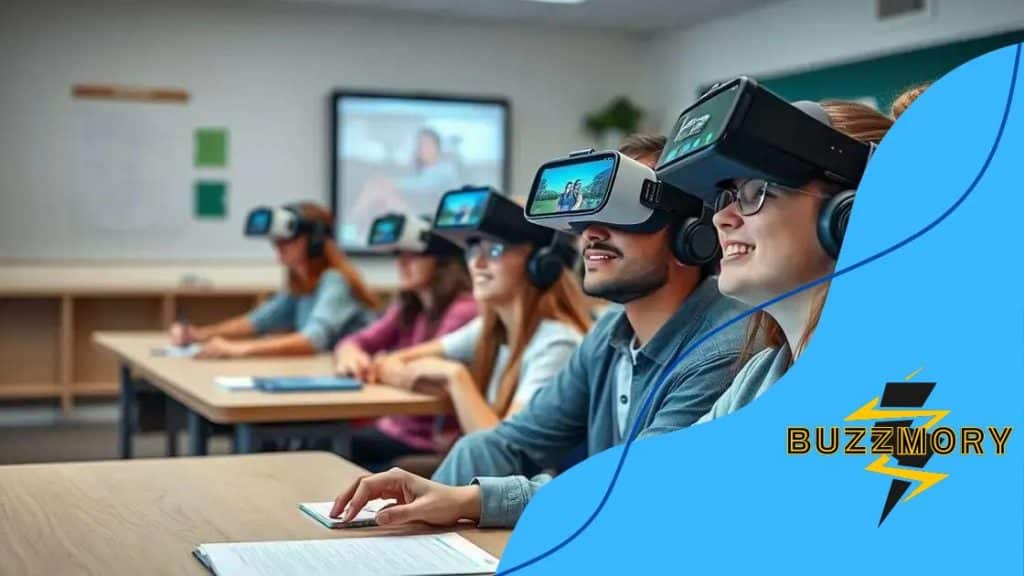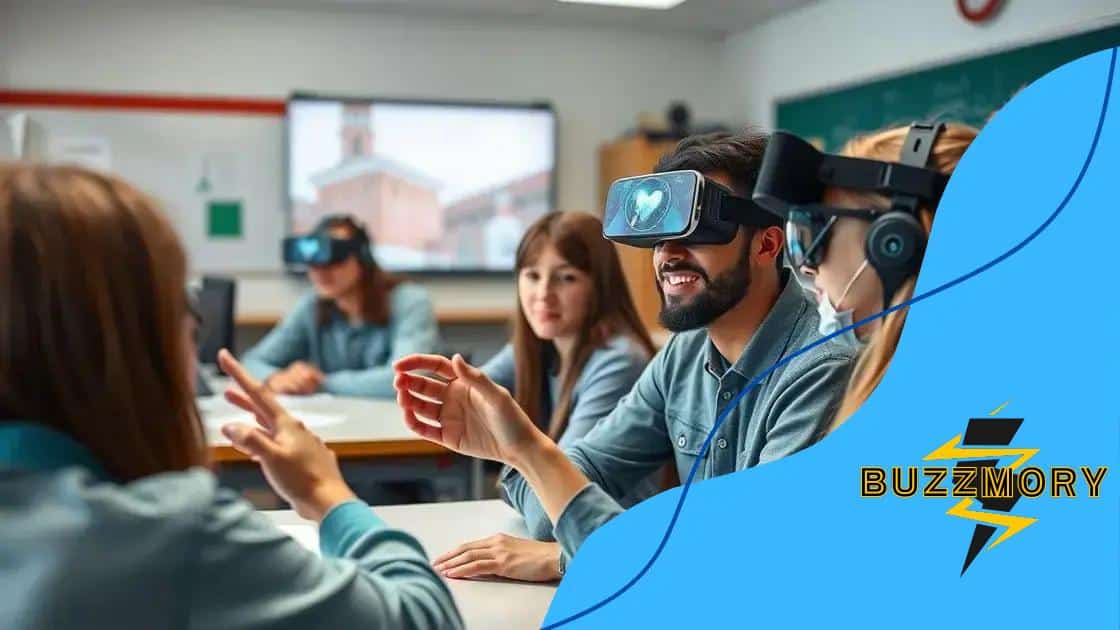How AR is being used for hands-on learning experiences

Augmented reality (AR) enhances hands-on learning experiences by providing interactive visuals, personalized educational content, and engaging methods that make complex subjects easier to understand for students.
How AR is being used for hands-on learning experiences is transforming traditional education. Imagine students exploring biology by virtually dissecting a frog or traveling through time to witness historical events. Curious about how this technology could change learning for good?
Understanding augmented reality in education
Understanding augmented reality in education is essential for grasping its transformative power. AR blends digital content with the real world, offering engaging learning experiences. This technology encourages active participation and makes lessons more immersive.
The Basics of Augmented Reality
In essence, augmented reality overlays digital information onto our physical surroundings. This can be seen in everyday applications like smartphone apps that recognize objects and provide additional context. In education, AR can revolutionize how students interact with complex subjects.
Benefits of AR in the Classroom
Utilizing AR in education comes with numerous advantages:
- Enhanced Engagement: Students become active participants in their learning journey.
- Improved Retention: Visual and interactive elements help with memory recall.
- Hands-On Learning: Complex ideas become tangible and easier to understand.
- Encouraged Collaboration: AR often involves group activities, promoting teamwork.
Furthermore, AR caters to diverse learning styles. Visual learners can absorb information better through interactive visuals, while kinesthetic learners benefit from hands-on activities. For instance, a student studying anatomy can explore human organs in a 3D space, enhancing comprehension.
Real-World Applications
Several educational institutions are already using AR effectively. In science classes, students can perform virtual experiments, reducing the risks associated with physical lab work. History lessons come to life as students can explore ancient civilizations through AR simulations.
Moreover, AR can assist teachers by providing valuable resources. Educators can create tailored lessons that spark curiosity, encouraging students to ask questions and explore topics in-depth. This technology helps to bridge the gap between theory and practice, making learning much more applicable to real-world scenarios.
Overall, understanding how augmented reality enhances education allows educators and learners alike to harness its full potential. As we delve deeper into its capabilities, the possibilities for innovative teaching methods continue to expand.
Benefits of AR in hands-on learning
The benefits of AR in hands-on learning are vast and transformative. This innovative technology significantly enhances the educational experience by making learning more interactive and engaging. With AR, students can visualize concepts that are otherwise difficult to grasp.
Enhanced Engagement
One key advantage of using AR is its ability to capture students’ attention. Traditional methods can often be passive and uninspiring. In contrast, AR provides a dynamic way to explore subjects, prompting curiosity and participation.
Improved Understanding
AR helps break down complex topics into manageable pieces. By allowing students to interact with 3D models or simulations, they can better understand abstract concepts. For instance, in science classes, students can examine molecular structures up close, making the material more relatable.
- Interactive Learning: Students can manipulate virtual objects, making lessons more memorable.
- Visual Representation: Difficult concepts become clearer through visual aids.
- Real-World Applications: Students can see how learning applies in real-life scenarios.
Additionally, AR fosters a sense of collaboration among students. As they work together on projects, they learn to communicate better and share ideas. This collaboration enhances their social skills while reinforcing the subject matter being studied.
Accessibility for Diverse Learners
Another notable benefit is how AR accommodates various learning styles. Visual learners can thrive with imagery, while hands-on learners engage with interactive tasks. This flexibility allows for differentiated instruction, ensuring that every student has the opportunity to succeed.
With AR, educators can create personalized experiences that reflect each student’s needs. This tailored approach makes learning not just more inclusive but also more effective in fostering a deep understanding of the material. Overall, the adoption of AR in education drives greater achievement among students by cultivating a rich learning environment.
Real-world applications of AR tools

The real-world applications of AR tools are transforming various sectors, especially education. These tools enhance learning experiences and make complex subjects more tangible for students. AR aids in visualization, turning abstract concepts into interactive lessons.
Healthcare Training
One prominent application of AR is in medical training. Future doctors can use AR to practice surgeries in a risk-free environment. They can visualize anatomy in 3D and interact with virtual patients, allowing for a deeper understanding of complex procedures.
Remote Learning and Collaboration
AR tools also facilitate remote learning situations. Students can collaborate virtually, sharing their insights and ideas through immersive experiences. Instead of reading about historical events, they can witness them through AR simulations, enhancing contextual understanding.
- Virtual Field Trips: Schools can take students on virtual trips to museums and historical sites.
- Enhanced Science Labs: AR offers virtual experiments that might be too dangerous or impractical in real life.
- Interactive Art Classes: Students can experiment with different art techniques without wasting materials.
Moreover, AR has applications in classrooms where kinesthetic learning is essential. For instance, students studying physics can visualize forces and motions with interactive simulations. This active engagement helps solidify their understanding of complicated theories.
Industry and Workforce Training
In addition to education, industries are leveraging AR for workforce training. Companies use AR to train employees on machinery and safety protocols. This hands-on approach allows new hires to learn in an immersive environment, reducing the time and resource costs of traditional training methods.
These real-world applications highlight how AR tools bridge the gap between theory and practice. As technology advances, the potential for AR in various fields continues to grow, offering innovative solutions to enhance learning and training.
Challenges of integrating AR in classrooms
The challenges of integrating AR in classrooms are important to address as schools adopt this innovative technology. While AR provides exciting opportunities for learning, there are hurdles that educators must overcome to fully benefit from its potential.
Cost and Resources
One major challenge is the cost involved in implementing AR technology. Schools often face tight budgets, making it difficult to invest in necessary hardware and software. Additionally, teachers may require training to effectively use AR tools, which can also incur expenses.
Technical Issues
Another obstacle is the potential for technical issues during classroom use. Not all schools have reliable internet access or sufficient technical support. When technology fails, it can disrupt lessons and lead to frustration for both students and teachers.
- Device Compatibility: Not all devices may support AR applications, limiting accessibility.
- Software Bugs: Glitches in the software can hinder the learning process.
- Learning Curve: Students and teachers may need time to adapt to new technology.
Furthermore, the effective use of AR requires adequate training for both educators and students. Teachers must understand how to integrate AR into their lessons meaningfully. Without proper training, the full benefits of AR may not be realized.
Curriculum Integration
Integrating AR into existing curricula is another hurdle. Some educators may feel overwhelmed by the prospect of changing their lesson plans to include this new technology. It’s essential for schools to provide support and resources to ease this transition.
Lastly, there’s the concern about equity among students. Not all students have access to the same technology or learning opportunities at home. This gap can widen existing inequalities in education, making it essential for schools to find solutions that bridge this divide.
Overall, addressing the challenges of integrating AR in classrooms involves planning, funding, and support. By understanding these issues, educators can work towards implementing AR in ways that enhance learning for all students.
Future of AR in educational experiences
The future of AR in educational experiences holds incredible potential. As technology advances, more schools are exploring how augmented reality can enhance learning environments. This innovative approach can reshape how students interact with educational content.
Expanding Accessibility
One significant development is the increasing accessibility of AR tools. As prices for AR technology decrease and internet connectivity improves, more schools can integrate these tools into their curricula. This means that students in various regions can access high-quality learning experiences.
Personalized Learning
AR opens the door to personalized learning. With augmented reality, educators can tailor lessons to meet individual student needs. For example, a student struggling with geometry can use AR to visualize geometric shapes, making the material easier to understand.
- Adaptive Learning Platforms: These platforms use AR to modify lessons based on student performance.
- Scalable Learning Opportunities: AR allows educators to scale content to suit different learners.
- Feedback Mechanism: Instant feedback through AR helps students improve their skills more rapidly.
Moreover, the integration of AR with artificial intelligence can create smarter educational tools. These tools can analyze student interactions and provide suggestions for improvement. This combination enhances the learning experience and makes education more interactive and engaging.
Innovative Teaching Methods
Another trend is the development of new teaching methods utilizing AR. Educators will increasingly rely on immersive experiences that bring lessons to life. For example, history classes can transport students to ancient civilizations or pivotal historical events, making learning unforgettable.
As these tools evolve, virtual and augmented reality will likely converge further. This evolution could lead to fully immersive classrooms where students can explore complex ideas hands-on. Imagine students conducting virtual chemistry experiments or exploring the human body in 3D!
The future of AR in education is bright. With ongoing advancements and a growing focus on immersive learning methods, educators and students can look forward to a dynamic educational landscape that will prepare them for the challenges of tomorrow.
FAQ – Frequently Asked Questions about AR in Education
How does augmented reality enhance learning in the classroom?
Augmented reality engages students with interactive visuals, helping them understand complex concepts more easily.
What are some challenges of integrating AR in education?
Challenges include costs for technology, training for teachers, and ensuring reliable internet access.
Can AR be personalized for different learning styles?
Yes, AR can provide personalized experiences that cater to various learning styles, making education more inclusive.
What is the future potential of AR in education?
The future of AR in education looks promising, with advancements that could create fully immersive and tailored learning environments.





